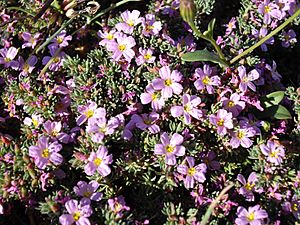Sea heath facts for kids
Quick facts for kids Sea heath |
|
|---|---|
 |
|
| Scientific classification | |
| Genus: |
Frankenia
|
| Species: |
laevis
|
Frankenia laevis, commonly called sea heath, is a small, low-growing shrub. It's a special plant that loves to live near the coast, often found in salty environments. This tough little plant is part of the Frankeniaceae family. It is quite rare in Great Britain.
Contents
What is Sea Heath?
Sea heath is a type of plant that grows close to the ground. It's known for its small, pinkish-white flowers and tiny, scale-like leaves. These leaves often have a grayish-green color. The plant forms dense mats, which helps it survive in harsh coastal conditions. It's a perennial plant, meaning it lives for more than two years.
Where Does Sea Heath Grow?
Sea heath is native to several parts of the world. You can find it in the southwest of Europe, including places like France, Italy, Portugal, and Spain. It also grows on islands such as the Balearic Islands, Corsica, Sardinia, and Sicily. Across the sea, it's found in the western parts of North Africa, in countries like Algeria, Morocco, and Tunisia. It also lives in the Azores, which are islands in the Atlantic Ocean, and in Great Britain.
This plant prefers coastal areas. It often grows in places where the soil is salty, like salt marshes, rocky shores, and sand dunes near the sea. Its ability to handle salt makes it a special type of plant called a halophyte.
How Does Sea Heath Survive in Salty Places?
Living by the sea can be tough for plants because of the salty water and strong winds. Sea heath has developed special ways to survive:
- Salt glands: Its leaves have tiny glands that can get rid of extra salt. This helps the plant stay healthy even when there's a lot of salt in the soil or air.
- Small leaves: The small, scale-like leaves help reduce water loss. This is important in windy coastal areas where plants can dry out quickly.
- Low growth: Growing low to the ground helps the plant avoid strong winds and protects it from salt spray.
- Deep roots: Sea heath can develop a strong root system. This helps it anchor itself in sandy or rocky soil and find water.
Life Cycle of Sea Heath
Sea heath usually flowers from late spring to summer. Its small flowers are often pink or white. These flowers attract insects, which help pollinate the plant. After pollination, the plant produces small seeds. These seeds can then be spread by wind or water, helping the plant grow in new areas. The plant's ability to spread its seeds and survive in tough conditions helps it continue its life cycle year after year.
See also
 In Spanish: Frankenia laevis para niños
In Spanish: Frankenia laevis para niños

